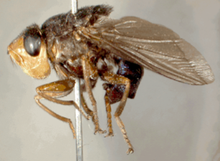| Dermatobia hominis | |
|---|---|

| |
| Adult female human botfly | |
| Scientific classification | |
| Domain: | Eukaryota |
| Kingdom: | Animalia |
| Phylum: | Arthropoda |
| Class: | Insecta |
| Order: | Diptera |
| Family: | Oestridae |
| Subfamily: | Cuterebrinae |
| Genus: | Dermatobia |
| Species: | D. hominis
|
| Binomial name | |
| Dermatobia hominis (Linnaeus Jr. in Pallas, 1781)
| |
| Synonyms | |
|
Oestrus hominis (Linnaeus Jr. in Pallas, 1781) | |
The human botfly, Dermatobia hominis (Greek δέρμα, skin + βίος, life, and Latin hominis, of a human), is a species of botfly whose larvae parasitise humans (in addition to a wide range of other animals, including other primates[1]). It is also known as the torsalo or American warble fly,[1] though the warble fly is in the genus Hypoderma and not Dermatobia, and is a parasite on cattle and deer instead of humans.
Dermatobia fly eggs have been shown to be vectored by over 40 species of mosquitoes and muscoid flies, as well as one species of tick;[2] the female captures the mosquito and attaches its eggs to its body, then releases it. Either the eggs hatch while the mosquito is feeding and the larvae use the mosquito bite area as the entry point, or the eggs simply drop off the muscoid fly when it lands on the skin. The larvae develop inside the subcutaneous layers, and after about eight weeks, they drop out to pupate for at least a week, typically in the soil. The adults are large flies lacking mouthparts (as is true of other oestrid flies).
This species is native to the Americas from southeastern Mexico (beginning in central Veracruz) to northern Argentina, and Uruguay,[1] though it is not abundant enough (nor harmful enough) to ever attain true pest status. Normally the greatest risk they pose to humans is increasing the chances of infection. Since the fly larvae can survive the entire eight-week development only if the wound does not become infected, patients rarely experience infections unless they kill the larva without removing it completely.

- ^ a b c "Human Bot Fly Myiasis" (PDF). U.S. Army Public Health Command (provisional), formerly U.S. Army Center for Health Promotion and Preventive Medicine. January 2010. Retrieved 2014-08-14.
- ^ Piper, Ross (2007). "Human Botfly". Extraordinary Animals: An Encyclopedia of Curious and Unusual Animals. Westport, Connecticut: Greenwood Publishing Group. pp. 192–194. ISBN 978-0-313-33922-6. OCLC 191846476. Retrieved 2009-02-13.